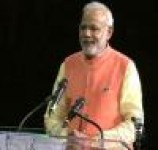Overhyping the Modi visit

While watching the live telecast of Prime Minister Modi’s powerful speech at the Madison Square on Sunday evening, I called my brother residing in Chicago, “Are you guys excited about listening to Modi’s speech at the Madison Square?” He replied, “Not so much. The coverage is positive though. Sundays for us are all about football and kids.”
Prior to Modi’s United Nations General Assembly (UNGA) address, American newspapers including the New York Times, Washington Post, and Chicago Tribunewere devoid of the Modi mania that had gripped the Indian television news channels. The superficial yet positive coverage of Modi’s US visit by American newspapers was in contrast to the high decibel reporting by the Indian media that created hash tags like #ModiinAmerica, #ModiinUS, #ModiAtMadisonand #NaMosteAmerica.
Most Indian media houses stationed their top correspondents in the US to cover Narendra Modi’s maiden visit as the Prime Minister of India. NDTV’s Barkha Dutt talked to excited women playing garba, Rahul Kanwal from Headlines Today spoke to the students at Columbia University, Bhupendra Chaubey from CNN IBN piqued our interest about Modi’s probable gift to President Obama and a nostalgic Maroof Raza from Times Now enlightened us about Muhammad Ali’s first bout against Joe Frazier at Madison Square. Unfortunately, Rajdeep Sardesai, the new Consulting Editor of theToday Group got a taste of live television when he was heckled and roughed up by Modi supporters few hours before the Madison Square event on Sunday. The frenzied crowd of young professionals booed him, refusing to answer any of his questions. I saw Rajdeep asking “Is this how Modi wants you to behave? Is this what the US has taught you?”
It was like a big social carnival bordering on hysteria with media men talking about everything except the strategic give and take. While we knew what we wanted from the US, what was expected of India was not discussed enough. If India wants the US to be stern with Pakistan on terror, is India ready to send soldiers to fight America’s war against ISIS? What about the Nuclear Liability Law and the situation in Afghanistan after the withdrawal of troops? Perhaps, the real issues of patent protection, flight of jobs etc will be dealt later in Washington.
On Friday and Saturday, prior to the Madison Square speech, Arnab Goswami from Times Now along with Maroof Raza, and Navika Kumar focused on the UNGA and Indo-Pak relations. According to Times Now, it was the first time India and Pakistan were de-hyphenated when it came to meeting President Obama and interacting with the CEO’s of the top US firms. The consensus was to ignore Modi’s counterpart from Pakistan and focus on the world affairs. Rightly so, since Kashmir is a bilateral problem and dragging the world in a bilateral issue meant taking the world’s attention away from terrorism.
Ironic how Times Now continued to tell us that the PM should not fall in the trap of limiting his speech to Pakistan and Kashmir but ended up doing just that - inviting Pakistani guests on prime time and pushing Pakistan on the mat. In a debate moderated by Editor-in-Chief Arnab Goswami, the panelists Maroof Raza, Strategic Affairs Analyst; Husain Haqqani, Former Ambassador of Pakistan to the USA; Kanwal Sibal, Former Diplomat; K C Singh, Former Secretary, MEA; Air Vice Marshal (Retd) Abid Rao, Defence Analyst; Reham Khan, Senior Journalist; and Tariq Pirzada, Strategic Affairs Analyst discussed whether Pakistan Prime Minister Nawaz Sharif's speech in the United Nations General Assembly was a self-goal for Pakistan.
Poking and shaming the guests from Pakistan was avoidable when our own PM had elevated his speech beyond Pakistan. While we wish to change the narrative by de-linking India and Pakistan, sections of the media remain obsessed with Pakistan. The muscular patriotism is perhaps designed to grab eyeballs. But such jingoism coming from news anchors is not a heartening spectacle.*
Shiv Visvanathan, a social commentator in wrote in Mail Today, September 28, 2014, “We need a media that is reflective, which understands strategy, tactics and time. It has to read the Modi visit as something more than a response to Nawaz Sharif. Foreign policy cannot be reduced to a set of social events. One has to read messages underlying politics and read them unsentimentally. This media fails to do so. Our emphasis is too much on personalities with little sense of tactics, details and issues. Media, I am afraid, has to mature if Indian foreign policy is to make an impact.”
So far, it has been a historic visit with Modi emerging as a visionary world leader who means business. I hope the hysteria of expectation does not end in a whimper when it comes to long-term outlook of ironing out the stubborn creases of the Indo-US relationship.
* Times Now’s debate from New York: #SharifSelfGoal
Relevant links:
PM Modi's US visit: Large Indian media contingent to cover Modi's US visit
Large Indian media contingent to cover NarendraModi's US visit
See how US media is covering PM NarendraModi's maiden visit to America
(AlkaGurha is an award winning blogger (http://www.alkagurha.com/) and a contributing writer for a weekly newspaper, Friday Gurgaon.)
Such articles are only possible because of your support. Help the Hoot. The Hoot is an independent initiative of the Media Foundation and requires funds for independent media monitoring. Please support us. Every rupee helps.






